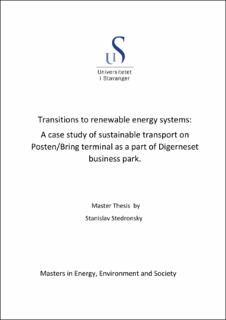| dc.description.abstract | The transition to decarbonized and sustainable transport in Norway is connected to electrification. In this context, renewable sources of energy can provide the clean energy needed for this process.
This thesis explores the possibility of developing a renewable energy system in the Digerneset business park to decarbonize the transport on Posten/Bring terminal. Hereby making it more sustainable. For this purpose, defining the dimensions of the energy demand for transportation combining it with the suitable dimensions of the potential renewable energy production and energy storage.
Three different scenarios have been constructed, one fully electric, others with a different share of hydrogen-based vehicles. This created three different demand profiles for the analysis. The scenarios were further divided into different versions based on battery storage and different logic behind electricity import. The method used is the energy demand and supply analysis based on hourly, daily, and monthly comparisons.
Results show that the energy system based on self-produced renewable energy is facing challenges related to the alignment of production with consumption. The modeled system overproduces energy during the summer, while the highest demand is during the winter months. The modeled system is further overproducing energy on the yearly balance in the fully electric scenario but underproduces in the case of hydrogen-based scenarios. Based on the intraday and hourly analysis, there is a need to import energy from the grid to meet the demand in all of the analyzed scenarios. The battery storage is improving the efficiency of the system and utilizes more of the produced energy. It can reduce the extra demand peaks during the charging of vehicles, reducing the cost of charging. Although the fuel-cell hydrogen trucks are seen to be more suitable for the longer distances with the heavy freight, the scenarios including hydrogen are further increasing the energy demand, so there is a need for a higher import of the electricity from the grid. They are also connected to significantly higher investment into electrolyzer cells. Because of the disproportion between production and consumption, there is a need for long-term storage of a high capacity to transfer and utilize the produced electricity. Hydrogen is a more suitable and cheaper solution for this, although there is a relatively high energy loss during the production. Storing the higher amount of energy in the battery is nearly 20 times more costly than storing it in hydrogen. Although the price of storage technology for both batteries and hydrogen is expected to decrease in the future, they will still be connected to high investment and need, therefore policy support and subsidies to become competitive. | |
